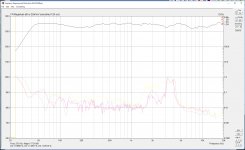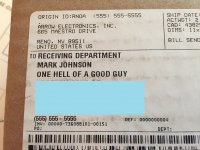distortion graphs for M2 compression driver (D2430K) on audioheritage site
D2430K compression driver information? - Page 5
cheers
Alan
How disappointing. Not quite state of the art as compared to my 5.2kg speakers @100 dB/m in anechoic measurement.

The tweeter is starting to rattle a bit, at this level, but the bass still stays under .1% up till f3.
One of the reasons is an efficient bass reflex enclosure so that cone movements on the low end are minimized. Another reason is Vac's secret sauce, for now.
No wonder. And I assume that peak output power capability with the SMPS was reduced as well.
I never tried to go full power today but it should have handled 200W/8 no sweat. I only went to 10W and threw in the towel. Not impressed at all, and I had wanted to listen also. Without the details... just bottom line -- NFG for ultra-low noise and distortion amplification. I dont know why it was the recommended one.
THx-RNMarsh
Last edited:
How disappointing. Not quite state of the art as compared to my 5.2kg speakers @100 dB/m in anechoic measurement.
View attachment 646287
The tweeter is starting to rattle a bit, at this level, but the bass still stays under .1% up till f3.
One of the reasons is an efficient bass reflex enclosure so that cone movements on the low end are minimized. Another reason is Vac's secret sauce, for now.
wait a minute. 0.1% ? Looks closer to 1.0% at mid freqs.
-RNM
Last edited:
Switching power supplies can be quieter than linears. Depends not only on the design, shielding but also how the linear handles and possibly creates line noise.
Therefore I suspect you are comparing a linear power supply with a well designed power transformer and appropriate other components to a switcher that may just meet EMI requirements or not.
Then as Pavel mentioned the switching supply had a brick wall fall off at the power limit. Linears have a bit of legs in that regard.
The story is told of the lifeboat service used to use power boats for easy rescues, but in bad conditions with storms and choppy seas manned boats were used.
The motor had hard limits. Men rowing in dangerous conditions could do well more than normal rated work.
(More from my stash of useless trivia.)
Therefore I suspect you are comparing a linear power supply with a well designed power transformer and appropriate other components to a switcher that may just meet EMI requirements or not.
Then as Pavel mentioned the switching supply had a brick wall fall off at the power limit. Linears have a bit of legs in that regard.
The story is told of the lifeboat service used to use power boats for easy rescues, but in bad conditions with storms and choppy seas manned boats were used.
The motor had hard limits. Men rowing in dangerous conditions could do well more than normal rated work.
(More from my stash of useless trivia.)
2K is not mid but high, just a bit over 3 octaves left. See my remark about the tweeter.
I am referring only to the 0.1% mentioned at bass freq. It isnt that low. Typo?
-RNM
In other shock news Richard put Prius tyres on his bentley and found acceleration suffers!
and is looking for the reason for funny smell...... like burning rubber.
-RM
It seems I did and I assume you might have read the result 😉
Yes, as they say in New England, "chum and they will come".
Richard, are you saying that you tried a switching power supply with your new Marsh power amp? I know that we discussed switching power supplies in the past, is this a test for suitability of switching power supplies for big amps? I am pretty sure that choke input linear is the way to go.
SMPS can definitely work in both small and big amps, it's just that SMPS are villains and needs to be tamed, they can't spit out RF crap up in the hundreds of MHz, and every PN junction with its intrinsic capacitances is a potential radio AM demodulator which means RF can alter biases just about everywhere in audio circuits.
Filtering isn't everything, also the switching behavior have to be carefully studied, a dirt simple way is to just increase the switching FET gate resistor and the di/dt will go down but so dose the efficiency of the SMPS, so the trick is to also get a good PCB design and strategically place filtering components in it's right places, not just at in/out-put.
For the power peaks I believe it's still good to have a few lytes smoothing the current discharges on demand, it's all about setting the FB in the SMPS to act properly fast, or slow if you will so it will better harmonize in concert with the lytes.
edit: A much better and favorable solution is of course to put the SMPS in a separate shielded box.
Filtering isn't everything, also the switching behavior have to be carefully studied, a dirt simple way is to just increase the switching FET gate resistor and the di/dt will go down but so dose the efficiency of the SMPS, so the trick is to also get a good PCB design and strategically place filtering components in it's right places, not just at in/out-put.
For the power peaks I believe it's still good to have a few lytes smoothing the current discharges on demand, it's all about setting the FB in the SMPS to act properly fast, or slow if you will so it will better harmonize in concert with the lytes.
edit: A much better and favorable solution is of course to put the SMPS in a separate shielded box.
Last edited:
I've come to the same conclusion as JC; I use a choke input linear regulator between an off the shelf switch mode power supply, and my headphone amp. Since my current demands are modest (<300 mA, class A), I use the Bourns RLB series of thru-hole inductors. They're small and cheap. Noisy 48VDC input, clean 38VDC output.
And you know the PSRR plot vs. frequency up to some 100MHz? The pain is that SMPS may send edges of 10ns - 100ns order and then PSRR at 50Hz (or 1kHz) does not say much.
And you know the PSRR plot vs. frequency up to some 100MHz? The pain is that SMPS may send edges of 10ns - 100ns order and then PSRR at 50Hz (or 1kHz) does not say much.
OTOH, a well designed SMPS keeps the junk on its board, and will not hang out the dirty linen. There's as much difference between SMPSs as between say power amps. It is just that we aren't used to characterize and understand SMPSs like we learned to characterize and understand power amps.
If somebody would say: I tried this SE amp, it sounds crap, thus all SE amps are crap, we would just smile.
But people do exactly that with SMPSs due to lack of understanding.
Jan
SMPS can be helpful in small enclosures as well. You can make a quiet linear supply but be careful where you place that transformer...
I agree with Jan.
I agree with Jan.
Found the plots Tom Christiansen did of basic linear supply, SMPS (Meanwell) and regulated (HP6643A). They all overlapped in the audioband and the only differences were in maximum output power between the options. So a good SMPS with a good amplifier topology seems to be a win win in many cases.
- Status
- Not open for further replies.
- Home
- Member Areas
- The Lounge
- John Curl's Blowtorch preamplifier part II
